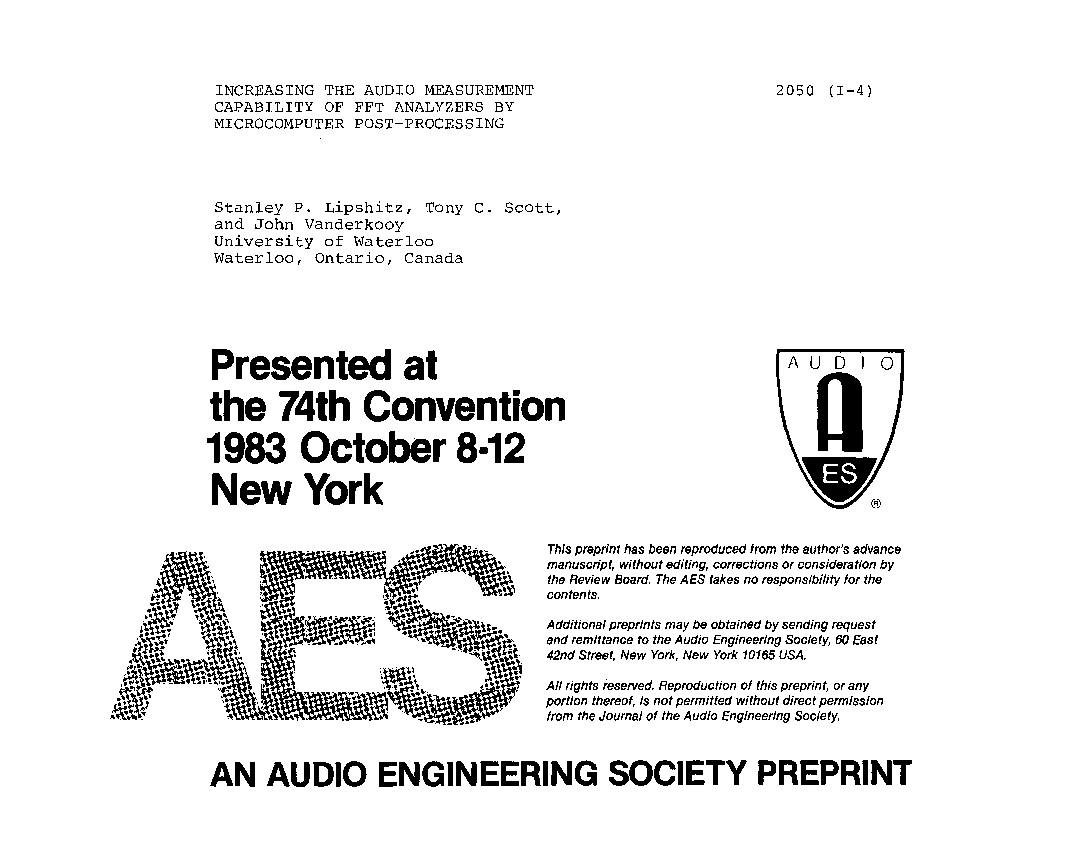Home / Publications / E-library page
You are currently logged in as an
Institutional Subscriber.
If you would like to logout,
please click on the button below.
Home / Publications / E-library page
Only AES members and Institutional Journal Subscribers can download
An FFT spectrum analyzer, especially a dual-channel device, can furnish increased measurement capabilities of its data can be sent to a microcomputer for postprocessing. This paper illustrates some of the additional capabilities which the authors have achieved, discusses their usefulness in audio measurement, and outlines their theoretical basis and the means by which they are computed. The FFT analyzer, in addition to acquiring the data, functions essentially as a rapid Fourier transform calculator and flexible display unit, while the data is suitably reconfigured in the microcomputer and shuttled forwards and backwards between them. We show the computation of a) the analytic signal and its envelope (i.e., the "energy-time curve"), b) the minimim-phase and excess-phase portions of a system`s phase response, c) constant relative bandwidth smoothing (e.g., 1/3-octave smoothing) of FFT spectral data, and d) the cumulative spectral decay plot (i.e., the "waterfall" plot of power vs. frequency vs. time).
Author (s): Lipshitz, Stanley P.; Scott, Tony C.; Vanderkooy, John
Affiliation:
University of Waterloo, Waterloo, Ontario, Canada
(See document for exact affiliation information.)
AES Convention: 74
Paper Number:2050
Publication Date:
1983-10-06
Import into BibTeX
Session subject:
Test and Measurement
Permalink: https://aes2.org/publications/elibrary-page/?id=11714
(1601KB)
Click to purchase paper as a non-member or login as an AES member. If your company or school subscribes to the E-Library then switch to the institutional version. If you are not an AES member Join the AES. If you need to check your member status, login to the Member Portal.

Lipshitz, Stanley P.; Scott, Tony C.; Vanderkooy, John; 1983; Increasing the Audio Measurement Capability of FFT Analyzers by Microcomputer Post-Processing [PDF]; University of Waterloo, Waterloo, Ontario, Canada; Paper 2050; Available from: https://aes2.org/publications/elibrary-page/?id=11714
Lipshitz, Stanley P.; Scott, Tony C.; Vanderkooy, John; Increasing the Audio Measurement Capability of FFT Analyzers by Microcomputer Post-Processing [PDF]; University of Waterloo, Waterloo, Ontario, Canada; Paper 2050; 1983 Available: https://aes2.org/publications/elibrary-page/?id=11714
@article{lipshitz1983increasing,
author={lipshitz stanley p. and scott tony c. and vanderkooy john},
journal={journal of the audio engineering society},
title={increasing the audio measurement capability of fft analyzers by microcomputer post-processing},
year={1983},
number={2050},
month={october},}